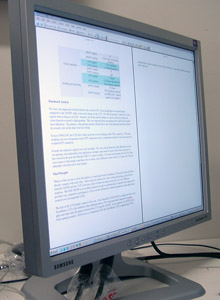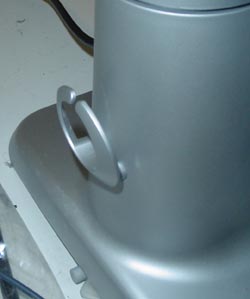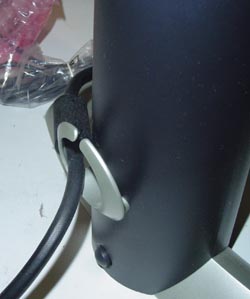Samsung SyncMaster 213T: The Glass Ceiling for Enthusiast LCD
by Kristopher Kubicki on February 20, 2004 4:24 AM EST- Posted in
- Displays
Construction
Indeed, the SyncMaster 213T and the Dell 2001FP share many similar design qualities. For starters, both monitors use a similar ring shaped stand with counter weighting. Both monitors also use comparable universal joints that allows the screen to pivot, tilt and rotate.
Check out how both LCDs use the same cable management.
However, past aesthetic design, these monitors begin to differ quickly. Each monitor consumes a similar footprint, but the 213T dwarfs the 2001FP in size. Where the 2001FP screen is 16" by 12" exactly, the 213T measures 17" by 12.75". A little bit of simple algebra concludes that the 213T has a screensize that is 11% larger than the 2001FP.
Samsung designed this LCD with modest input design; there are no frills. Below you can see one DVI and one 15 pin D-Sub input, as well as an AC power socket. We have seen many other less expensive units with more input options, so the lack of S-Video or composite options is a slight disappointment. We have mentioned in the past that LCDs with TV signal processing are often subject to much higher "consumer electronics" import duties, as opposed to "computer display" duties. It is probably likely that Samsung has not opted to incorporate TV support to keep this unnecessary cost down.














33 Comments
View All Comments
SLCentral - Sunday, February 22, 2004 - link
Great review, but my question is how the hell did you get the picture on the first page (with the display that has anandtech.com on it) to show the review already online? :-Dwrong - Sunday, February 22, 2004 - link
I bought a Dell 2001FP. It was nice and crisp, but the textured appearance of solid color areas was quite distracting. It would not reliably sync to the various text modes passed through during boot. Worst, it FLICKERED in a kind of checkerboard pixel pattern when things moved, as if it was really an 18-bit panel and was using a 2x2 pixel dither pattern.Either I got a dud, or AT's model had a different panel to mine. Not sure which. I sent mine back and got a CRT. (Not fond of Dell tech support either.)
Workin' - Sunday, February 22, 2004 - link
I've been using a 213T for about 2 months now and it is a fantastic display, absolutely worth every penny of its price!I run mine on the DVI output of a Radeon 9600, and the picture is simply stunning. Also, my panel has zero pixel defects, which is amazing considering there are almost 6 million subpixel elements.
KristopherKubicki - Sunday, February 22, 2004 - link
wizardsinc: Sapphire makes a bunch of dual DVI AGP cards - you might have to special order them but they are totally worth it. As of November I heard that dual DVI accounted for less than 1% of graphics card sales.Kristopher
wizardsinc - Saturday, February 21, 2004 - link
I just thought I'd post an update: A friend of mine just bought a Dell 2001FP, so I was finally able to compare the Dell & Samsung 213T side-by-side. I'd have to say that I agree 100% with Kristopher: The Dell is absolutely beautiful, but the Samsung sitting next to it looks even better. The main differences I could see (besides the obvious physical size differences) were: (a) The Samsung was softer on the eyes and appeared brighter and "whiter". (b) The lines between pixels on the Dell were much more obvious than on the Samsung - when sitting side-by-side, the Dell looked like I was seeing the image through a small screen mesh (very crisp). The Samsung has nicely defined pixel bounderies, but the line between pixels is not as apparent. (c) In Dell's favor - the 16ms vs 25ms refresh rate difference was noticable. Small fast-moving images would fade slightly on the Samsung, where they would remain intact on the Dell. All-in-all though, I decided that for my purposes, the Samsung was the winner. There is currently a $100 mail-in rebate on the Samsung, bringing the price down to $1100 at Best-Buy, so I picked up a couple of them. I've already set them up and I must say they're awesome running side-by-side! :-) Now I have to upgrade to a video card that supplies two DVI outputs (I'm currently running 1 DVI & 1 VGA). Any suggestions? I'm under the impression that Nvidia might be a better choice over ATI, but I could be wrong. Again, any suggestions are welcome!Thanks to all of you for aiding me in my display purchase decision. It's great when discussion groups work. ;-)
KristopherKubicki - Saturday, February 21, 2004 - link
TauRusIL: Interestingly enough, samsung makes a majority of the components including panels. One of the reasons we look at so many Samsung LCDs is just because they typically sell the panels to several other mainstream OEMs.Kristopher
gizzard - Saturday, February 21, 2004 - link
PrinceGaz - Saturday, February 21, 2004 - link
You don't need a hack to make XP run at 640x480 (or to use a 256-colour mode at any resolution either). Just press the 'Advanced' button and select the Adapter tab, then press 'List All Modes...' button and you'll find the hidden modes listed and selectable.Vey useful for some older games which won't run full-screen unless started from 640x480, and a few which won't run at all if not in a 256-colour mode.
TauRusIL - Saturday, February 21, 2004 - link
I noticed most of the LCD panels reviewed here are made by Samsung. I wonder if there were any plans to include LCDs from other manufacturers.I am a long time and very happy user of Princeton SenErgy line of LCDs. To my eyes, the picrure quality of Princeton Senergy line is way above most of other LCD panels. Of course this is a subjective view.
I would love to see a comparative review of the Princeton Senergy and lets say Samsung or Dell panels.
On the side note: does anyone know who is the OEM for Princeton line of LCD panels, or do they make their own panels?
dgrady76 - Saturday, February 21, 2004 - link
Great review. I'd like to see more of the "subjective analysis" in the hardware reviews at AT (as long as it's labeled as such, of course). Hard numbers can omit many truths about a product's actual performance.